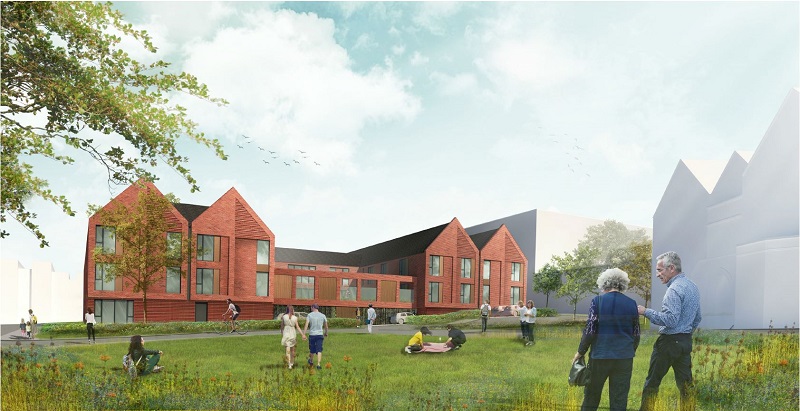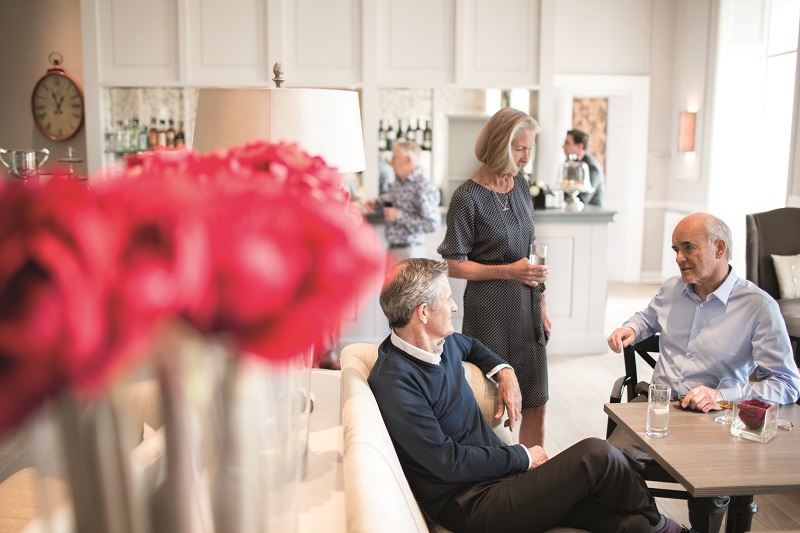Architects are calling on the Government and industry to implement new minimum standards for the design of social care facilities after the COVID-19 pandemic exposed serious flaws in current premises.
The team at Birmingham-based Glancy Nicholls Architects has won numerous design awards for its care home developments, including a RIBA Award for the Meadow View project in Matlock, Derbyshire.
And it has just completed the Ada Bellfield Centre in Belper, which was handed over to Derbyshire County Council last month.
It is clear that there is much to be done in the sector to provide better care for those who need it
Due to its forward-thinking design, the facility is currently being used as an isolation unit for COVID-19 patients prior to residents moving in.
And the team is keen that it will act as a springboard for widespread improvements to social care homes across the UK.
Associate, Danielle Swann, told BBH: “The coronavirus pandemic has highlighted a raft of shortcomings within care homes in the UK, with many unable to meet the current needs of residents.
“We believe that more needs to be done to promote the wellbeing and safety of residents, as well as care staff, through quality design and layout of care buildings, with many older facilities no longer fit for purpose.”
In particular, the current trend in care home design, as well as the type of care needed by many residents, makes social distancing and self isolation virtually impossible.
“With an aging population, and lessons learnt from the impact of COVID-19, it’s imperative that we, as a society, protect and maintain the dignity and quality of life of our older generation,” Swann said.
“Care homes have been badly hit by the recent outbreak of Covid-19 and we need to learn from this in order to adopt best practice in the future.
“It’s imperative, moving forward, that we raise the bar with regards to the design of care homes in the UK.
“We must deliver high-quality environments with the flexibility to respond to future outbreaks of this nature, ensuring the safety of residents and staff.”
And new minimum standards will help to ensure this, she adds.
“New standards should include the provision of multiple smaller shared spaces throughout the building, offering different rooms for different functions; a minimum width of 2.5m in all shared spaces, including corridors; and private bathroom facilities for all residents,” she advises.
We believe that more needs to be done to promote the wellbeing and safety of residents, as well as care staff, through quality design and layout of care buildings, with many older facilities no longer fit for purpose
“Bright, light spaces with plenty of windows for ventilation should also be included.”
Where possible, she argues, care homes should be designed so that residents can be grouped into separate households of between eight and 10 people, with their own common areas.
Layouts should also be carefully planned so that each household can be accessed by staff and visitors without having to walk through another household, thus reducing the risk of spreading infection.
But, in order to achieve this, the overall capacity of care homes will need to be reduced, and this will have an impact on income for social care operators.
Swann said: “We should also learn from best practice in other countries where spaces are designed to enhance resident’s emotional and social wellbeing.
“Take Holland, for example, where best-practice care homes incorporate more outdoor ‘pods’ and social spaces for residents; providing private and secure areas for people to meet friends and family.
“There is overwhelming evidence that access to quality, external space has a positive impact on physical and mental health, so an emphasis on providing quality outdoor space will be key to improving the quality of care home design in the UK.
“The main barrier to achieving anything like the standards that are required, though, comes down to funding.
“Social care has been underfunded for years and it needs significant and sustained investment from central government to bring it up to the standards needed.”
This call for a new approach is supported by Jitesh Patel, senior development manager at Kajima Partnerships, who said that, without new investment and development, 13 million older people could be living in unsuitable households by 2040.
Research reveals that just 2.5% of the UK’s housing stock is defined as retirement housing, and only 0.7% consists of purpose-built homes offering care, he reveals.
Social care has been underfunded for years and it needs significant and sustained investment from central government to bring it up to the standards needed
And this shortfall has a significant impact on hospital services, with an increase in bedblocking – up 50% on 2014 – being set against a rapidly-reducing number of available acute hospital beds – down by 34% since 1989.
These figures have led to ministers calling for new step-down accommodation and extra care facilities to be built across the UK.
But, with so much pressure on the system, it is imperative, Patel said, that new buildings are of high quality and designed specifically for the needs of residents and those delivering care.
He said: “The good news is that technology and data can vastly improve efficiency and quality of care, alleviating overstretched resources.
“This is especially important as the cost of chronic conditions is expected to be around £13billion a year.”
And this focus on technology will be vital alongside the necessary improvements to design standards.
Patel said: “Innovations such as digital care notes and online consultation services can help to identify changes in health conditions and mobility more easily, without compromising people shielding.
“This will help both carers and patients move towards a healthier future, faster.”

Kajima Partnership's Jitesh Patel said technology would play a key role in improving care environments moving forwards. Pictured is the company's Springfield development
And, with COVID-19 at the forefront of everyone’s minds, patients can also be protected by improved technology in a more-indirect manner.
For example, contactless interfaces, like smart badges used for ID and security measures, help to minimise health risks in high-density residential areas and enable people maintain their independence.
An inability to accurately track data within the care sector during COVID-19 has also been widely criticised, as allowing the crisis to continue under the radar.
Indeed, it has been estimated that, due to inaccurate symptom reporting, one in four coronavirus cases goes unreported.
Solving this issue is, however, easier said than done, with healthcare providers having to keep track of more devices, equipment, and other medical assets than ever before.
It is, therefore, imperative that specific, targeted measures are taken to ensure care providers can prevent such oversights from happening again.
“The call from senior care leaders to lift lockdown in care homes amid growing mental health concerns has highlighted the need to balance safety with community,” said Patel.
“Integrating with community services and combining facilities will be paramount in ensuring those in care are not experiencing such emotions.
“Small improvements, such as en-suite rooms with communal dining and living facilities for smaller cohorts of residents can provide privacy, dignity and the best control for potential infection, as well as the chance for socialisation.”
COVID-19 and its unique challenges may have kick-started the changes in development, technology and policy that the sector has desperately needed for some time
He adds: “It is clear that there is much to be done in the sector to provide better care for those who need it.
“However, COVID-19 and its unique challenges may have kick-started the changes in development, technology and policy that the sector has desperately needed for some time.”
The adoption of innovative technology will also help to address the care home staffing ‘black hole’ whereby the sector has lost frontline staff due to the impact of the Government’s Immigration Bill.
But alongside this need for improvements in the design of care home environments, and the adoption of assistive technologies, is there also an argument for a shift to a different care model altogether?
According to Paul Morgan, managing director of Audley Group, the retirement village provider owning 20 villages across England, the answer is ‘yes’.
And this new model should be based around an increase in the creation of retirement villages – which offer older people a home for life, but with support and care services on tap.
The concept sees older people moving into homes within communities.
Each home has its own front door, which has proved critical in helping to contain the spread of coronavirus during lockdown.
Morgan told BBH: “Retirement villages are about maintaining your independence and relieving the pressure on care homes and the NHS and this should certainly be a direction of travel for the country moving forwards.

As well as improving care home design, Audley Group believes retirement villages will become more prevalent across the country, offering a more-independent option which also makes it easier to control the spread of infections such as COVID-19
“When lockdown became inevitable we were able to take immediate action.
“While care home restaurants had to remain open, potentially adding to the risk of the virus spreading; we were able to close our on-site restaurants and begin a social-distancing delivery service.
While there will always be a need for traditional care homes, the last three to six months has shown us there is an alternative, and a good alternative
“We were also able to continue providing exercise classes and other social activities, either virtually or by residents coming out onto their balconies or into their front gardens to join in classes.
“We had meetings every morning and if anyone showed any signs of the virus, then because they had their own space they could isolate easily, but had the support on hand if needed.
“If people can move into communities where they can maintain their independence and receive the services they need, we can reduce the reliance on the care system and free up space in care homes for those people who have no alternative.
“While there will always be a need for traditional care homes, the last three to six months has shown us there is an alternative, and a good alternative.”
